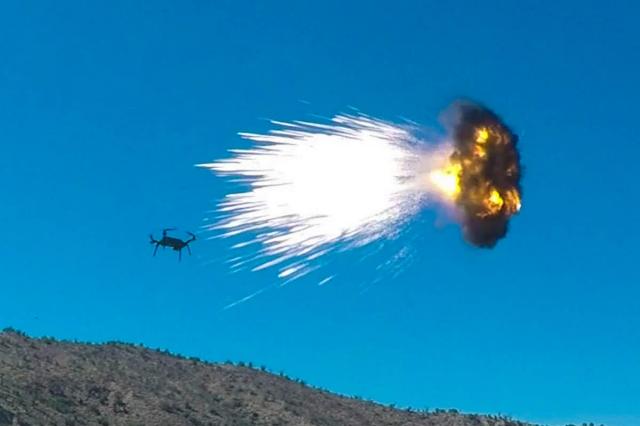The use of unmanned aerial vehicles (UAVs) and barrage munitions (BB) over the battlefields in Ukraine are just some of the aerial threats that have forever changed the combat space. According to European military analysts, the capabilities of programmable munitions in general and their latest medium-caliber developments related to the battlefields in Ukraine and beyond can improve the effectiveness of air defense against massive attacks by drones and other aerial targets.
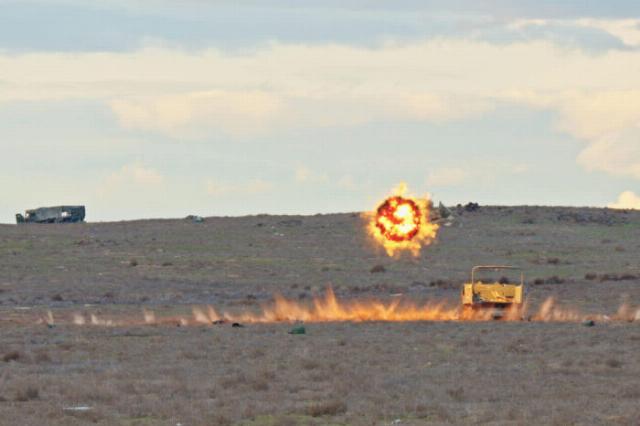
Aerial demolition
Air blasting technology
Gunners have always preferred to hit a target at close range or by aerial detonation when faced with such descriptions of targets as "troops in the open." For more than 100 years and during various wars, medium and large caliber guns were used by OFS, whose fuses were set to detonate at certain altitudes with the formation of a large number of fragments in the air. Today, this opportunity is more relevant than ever not only to combat low-altitude aircraft and helicopters, but also for the aforementioned UAVs/BB, which are also widespread in Ukraine.
In this regard, various medium-caliber ammunition and ways of programming them appear, which increase the effectiveness of existing and promising short- and ultra-short-range air defense systems (SHORAD/VSHORAD) and automatic guns. Air defense systems supplied by the Armed Forces of Ukraine (AFU), such as the German Skynex complex, are designed to change the course of the war. However, first let's take a brief look at the market for programmable ammunition.
The market for programmable ammunition. Condition
In a recent report on the trends in the development of the PrB market over the next five years, the research company Mordor Intelligence (India) predicts its significant growth. It will be supported by the requirements of high-precision guidance, as well as an emphasis (on the part of some countries that adhere to generally accepted norms and laws of armed conflict) on reducing potential collateral damage when using ammunition of any kind. This is a problem that the PrB can mitigate to some extent due to greater predictability.
In the study, the PrB market is classified by caliber (from medium to large), type of ammunition (guided or with target detection) and type of detonation (including detonation at a specific point, wireless remote, time-programmable and detonation at close range). In the latter case, for medium-caliber ammunition, programmable proximity effects for air defense systems have been enhanced in recent years due to advances in miniaturization, communications and sensor technologies. Indeed, most of the market growth is expected in the medium caliber segment, which includes 20, 25, 30 and 40 mm projectiles of various specifications, some of which are being developed specifically to meet new detonation requirements to defeat modern UAV threats.
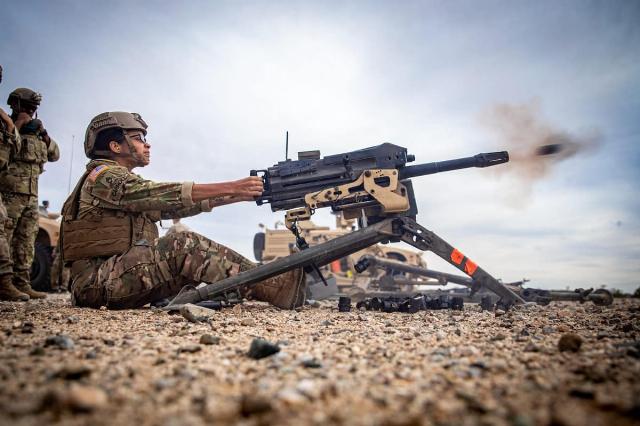
Such manufacturers as the German Rheinmetall are achieving success in the field of PrB. This is evidenced by contracts concluded in January 2023 for the supply of 40 mm ammunition to two unnamed European NATO members, including low- and high-speed variants, as well as 45,000 projectiles of programmable high-speed high-explosive high-explosive tracer ammunition of 40 mm x 53 caliber (HV HE-T ABM), the supply of which It is scheduled for the first half of 2024.
The study also highlights that the lion's share of market growth is expected in North America, where ammunition manufacturers are already investing significant resources in research and development of advanced medium- and large-caliber next-generation programmable systems. One of the leading North American players in this regard is Northrop Grumman. In turn, European companies leviathans, BAE Systems, Nammo and Rheinmetall are all very interested in the war in Ukraine and the changing nature of the battlefield in terms of supporting their own development of programmable ammunition.
Smaller manufacturers are also making progress. The report, for example, mentions the medium-caliber PrB of the Serbian Military Technical Institute, where a programmable short-range/air-detonation projectile was developed for a new version of the single-barreled 40 mm L/70 Bofors automatic cannon of the PASARS-16 short-range self-propelled hybrid air defense system. It is reported that the shells of the gun are designed primarily to destroy UAVs and, when detonated near the target, release 1,100 fragments of tungsten shrapnel. Standard ammunition for the cannon is produced by the Serbian defense plant Sloboda.
The study also drew attention to the current developments of the US Army's short-range air defense program (M–SHORAD) to create an air-detonation projectile effective against drones, as well as various ground targets, highlighting the multimode non-contact air-detonation offset (MMPA) XM1223 HE (more on this below) as part of the last phase of the program - "Increment 3".
Programmable Skynex and AHEAD effects
According to Western estimates, Skynex is a powerful ultra–short-range air defense system based on an automatic cannon. Moreover, its use with Rheinmetall's programmable 35 mm AHEAD ammunition is much more efficient and much cheaper than using guided missiles at such ranges. Both ammunition with non-contact air detonation (airburst/proximity munition, ABM) and armor-piercing ammunition with a delayed-action kinetic fuse (kinetic energy time fuze, KETF) are available. Unlike their missile counterparts, the 35 mm projectiles are immune to electronic countermeasures.
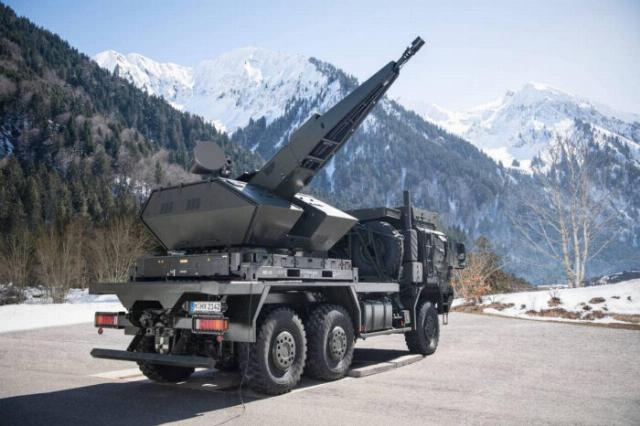
Skynex air defense systems were delivered to the Armed Forces during 2023 and 2024, along with programmable 35 mm AHEAD ammunition. Other systems and ammunition are under order.
Skynex's main armament is the Oerlikon Mk3 35mm automatic cannon, which is equipped with an integrated radar and an optoelectronic sensor unit. But in the context of the topic under discussion, the programmable ammunition AHEAD is of interest. This type of projectile, which has been used for several years for various 30/35 mm caliber guns, is effective against ground threats, as well as conventional low-flying aerial targets, drones and barrage ammunition common in Ukraine. In the case of Skynex, the programmable fuse of the 35 mm x 228 AHEAD projectile contains an electronic timer module that is "programmed" using electronic induction (this process, by itself, has been used to install fuses of 105 and 155 mm caliber artillery ammunition in an artillery position for many decades.)
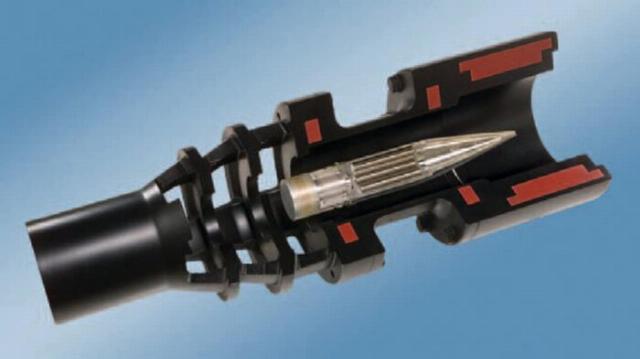
An incision of a 35 mm AHEAD programmable projectile passing through an induction field inside the barrel, where the fuse is programmed/installed
Since each 35mm projectile passes through an induction field inside the muzzle when exiting the weapon, its muzzle velocity is used to determine any adjustments in detonation velocity and time that must be set for each projectile when passing the muzzle so that it detonates at its own optimal target interception point.
It is worth noting that although the standard ammunition of the Mk3 Oerlikon cannon is 252 rounds, it can fire 1,000 rounds per minute at a range of about 4.5 km, usually firing 24 rounds at a time. Upon detonation of a small, 1 g ejection charge directly in front of the target, the AHEAD projectile releases its combat load. In the case of the 35 mm Oerlikon KETF/AHEAD PMD062 projectile, used to defeat a wide range of aerial targets, the combat load is 152 cylinders, weighing 3.3 g of tungsten alloy with rotation stabilization. After detonation, the cylinders form a deadly cone of shrapnel in front of the target's trajectory, increasing the likelihood of hitting it, especially at long distances.
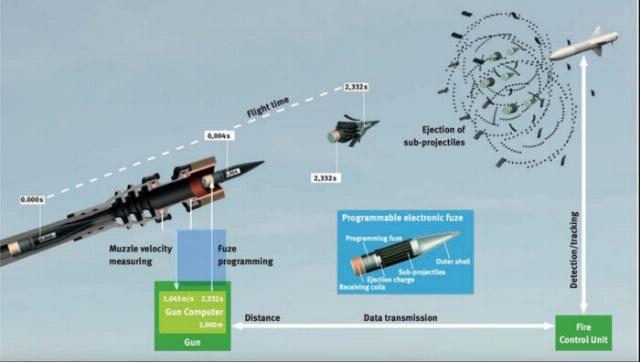
The scheme of operation of the AHEAD air detonation device from induction tuning / programming in the muzzle to scattering of the projectile's striking elements during detonation at the end of the trajectory.
The second configuration for air defense tasks (although it is better suited for destroying small, fast and maneuverable targets) is the 35 mm Oerlikon KETF/AHEAD PMD428 projectile, which produces more than 600 striking elements (PE). The greater the amount of PE, the higher the probability of hitting the target. In both cases, the cloud of aerodynamic submarines is potentially capable of penetrating control surfaces and vital target systems.
It is reported that during tests by Rheinmentall in mid-2021, 35 mm air-detonation ammunition AHEAD against a swarm of eight UAVs, a burst of 18 shells destroyed all targets. At the same time, tests showed that all eight were destroyed after the detonation of the first six shells, which also indicated the additional value and potential savings in ammunition consumption when using AHEAD shells. The effect of aerial detonation is critical not only for drones and BB, but also effective against anti-radar, anti-ship and cruise missiles, as well as aircraft and helicopters.
In addition to 35 mm x 228 rounds for systems such as Skynex, AHEAD technology is also embedded in 30 mm x 173 projectiles for use with several land-based automatic guns as well as naval melee systems. The technology has evolved to be effective for special applications, including "missile, artillery and mortar counteraction" (C-RAM) missions, where projectiles have been developed that are effective at destroying approaching artillery and mortar shells, as well as MLRS missiles flying along parabolic trajectories.
Programmable projectiles for the M-SHORAD missile defense system
Meanwhile, the US Army is moving forward with its new short-range M-SHORAD (Mobile/Maneuver Short Range Air Defense) anti-aircraft missile and cannon systems. The complex is made in three versions, called "Increments".
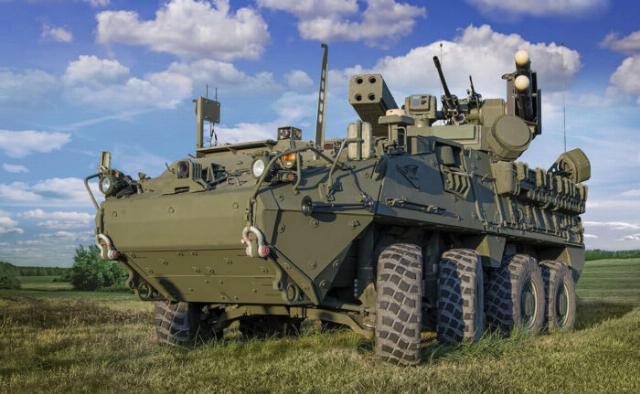
ZRPC M-SHORAD based on the Stryker armored personnel carrier
Designed to provide air defense against low-altitude aerial threats, as well as stationary and low-mobility critical facilities, M-SHORAD has expanded its scope of activity and now covers the threat from UAVs, which was demonstrated in Ukraine. The first systems, including a full set of weapons, sensors and technical means in the "Increment-1" variant, entered the US Army in 2021 and, in the context of the topic, include the XM914 automatic 30 mm × 113 cannon, which uses the standard XM1211 remote-controlled OFS (HEP) and dual-purpose OFS with self-destruct function (HEDP-SD) XM1198
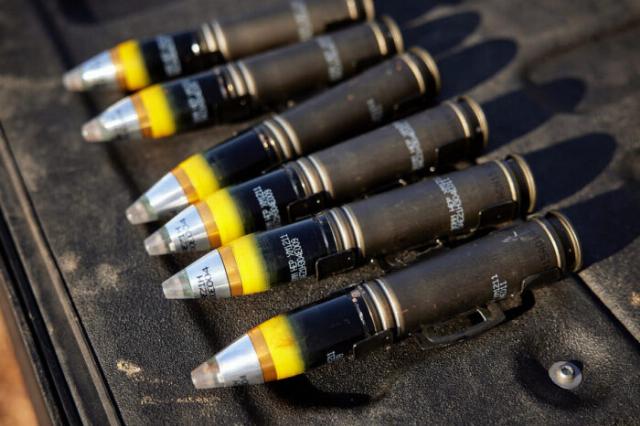
The XM1211 HEP (pictured) and XM1223 MMPA are manufactured by Northrop Grumman. The latter should be applied by M-SHORAD Increment 3 and used against a wide range of targets, including unmanned aerial vehicles.
However, it is in the "Increment-3" version that these 30 mm automatic guns will also receive a new programmable munition - the multimode non–contact air detonation (MMPA) XM1223, which is being developed by Northrop Grumman starting in 2024. This new projectile is designed to combat drones and ground targets and is likely to eventually replace the XM1211 and XM1198 due to its versatility against a wider range of both aerial and ground targets.
A demonstration of the M-SHORAD "Increment-3" technology is planned by the US Army for the end of 2024, an operational demonstration for 2026, and a production decision for 2027. Meanwhile, the company has already delivered its Mk310 programmable airburst munition (PABM), which it has also developed in collaboration with the US Army.
The Mk310 is a non–contact projectile with a fuse that is programmed before firing using calculated data. The calculation is based on the number of revolutions that the projectile must make in flight before detonation in order to ensure an accurate defeat by an air explosion. It is believed that the scheme is appropriate against UAVs or enemy troops entrenched on the ground.
The company also says it is in the process of developing a new guided munition that combines PABM technology with in-flight continuous course correction capabilities. This will allow the projectile to be accurately guided to the target, optimizing the probability of being hit by the first projectile, as well as minimizing the likelihood of collateral damage.
Thus, experts conclude, the latest threats on the battlefield have forever changed the ways of warfare, forcing air defense systems to adapt or die. It seems that the adaptation has spurred on the leading players in the industry and given a new impetus to the latest programmable air-detonation munitions. Some of them have already been tested in operation, while others are being tested on the battlefields in Ukraine. The latter, Western experts hope, "will make it possible to change the situation in the defense of this country – and, possibly, the rest of Europe."
Based on the materials of the resource euro-sd.com
